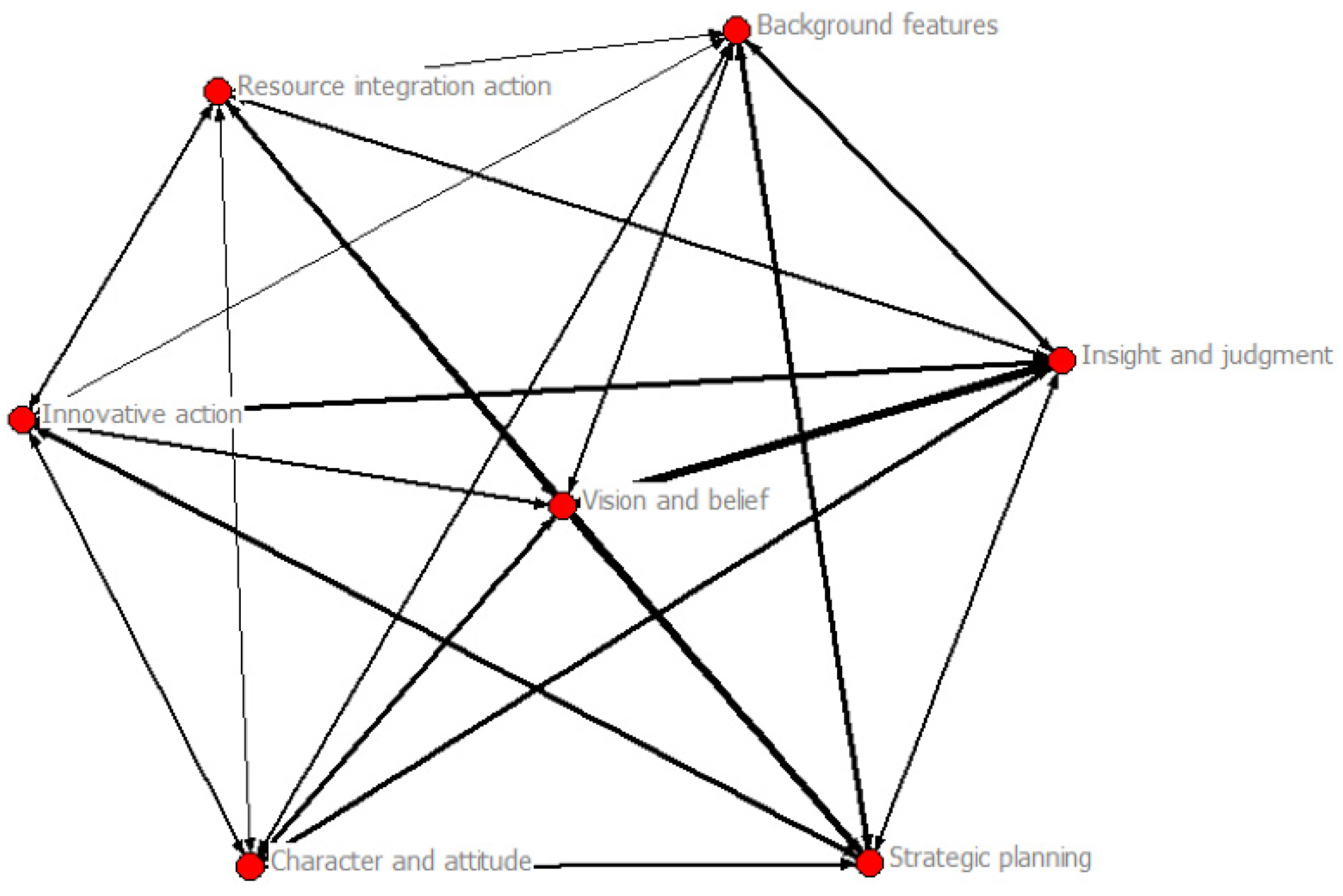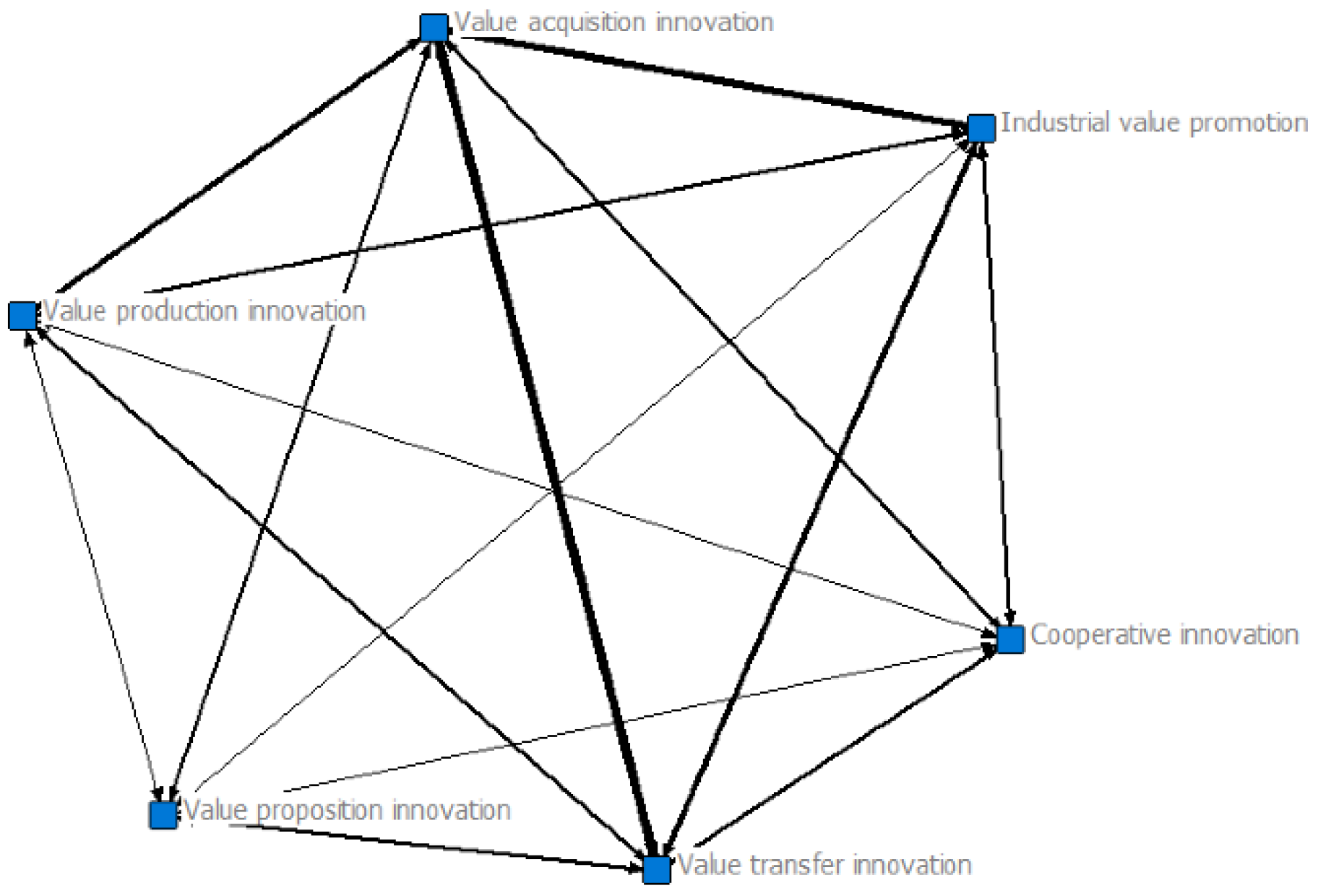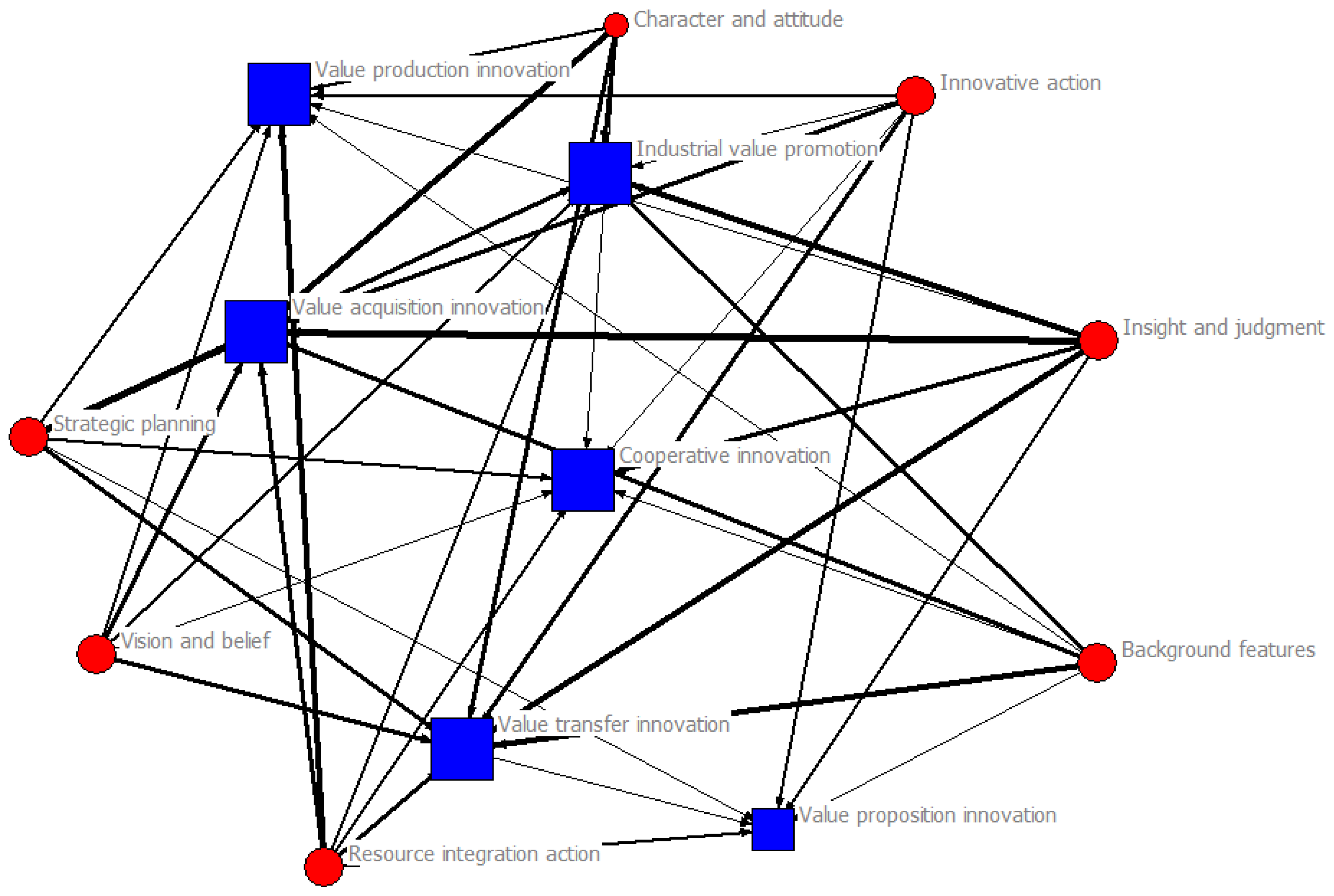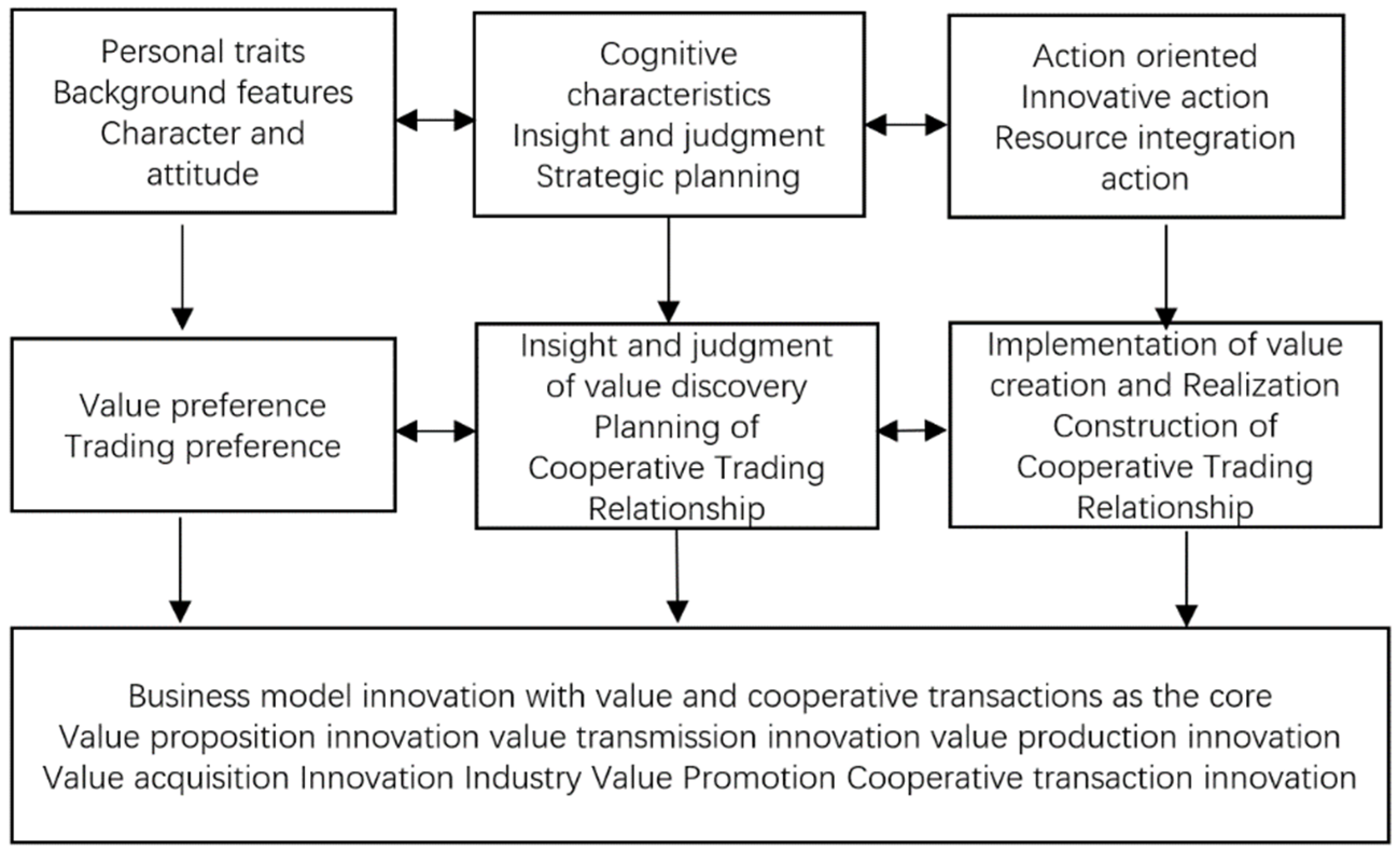How Do the Chinese New Farmers’ Entrepreneurial Talents Drive the Business Model Innovation of Agricultural Business Organizations? Case Study Based on Grounded Research
Abstract
1. Introduction
2. Literature Review
2.1. BM and BMI
2.2. Entrepreneurial Talent and Farmer Entrepreneurship
3. Research Methods and Research Process
3.1. Source of Cases
- Background information collected by the research team from the open media;
- Audio recordings of in-depth interviews with the directors of the 32 operating entities of the Agricultural “maker spark” and their translation into text. Open-ended questions were used in the interview, mainly including the following: “Tell me about your process of building and operating ‘maker spark’?” “What development goals and strategies have been set?” “What are your attempts and major innovations in your business model?” “What was the main difficulty facing you? How was it solved?” “What attempts have been made to address sustainability issues?”, etc.;
- The information obtained from interviews and observations made by team members; each case was assigned 3–5 investigators to form an investigation team to collect centralized information and discuss, and then reached a consensus on the investigated business model of “maker spark” and formed a descriptive text of the business model of “maker spark”. Eventually, a text of about 160,000 words was formed as the basis for coding.
3.2. Encoding Process
3.2.1. Open Coding of Entrepreneurial Talents of New Farmers
3.2.2. Axial Coding of Entrepreneurial Talents of New Farmers
3.2.3. Open Coding of BMI Activities of New Farmers
3.2.4. Axial Coding of BMI Activities of New Farmers
3.2.5. Network Analysis of the Concepts of Entrepreneurial Talents and BMI Activities
3.2.6. Selective Coding
3.2.7. Theoretical Saturation Test
4. Discussion
5. Conclusions
Author Contributions
Funding
Institutional Review Board Statement
Informed Consent Statement
Data Availability Statement
Conflicts of Interest
References
- Christensen, C.M. Competitive advantage. Mit Sloan Manag. Rev. 2001, 42, 105–109. [Google Scholar]
- Osterwalder, A. The Business Model Ontology a Proposition in a Design Science Approach. Ph.D. Thesis, Faculté des Hautes Etudes Commerciales, Université de Lausanne, Lausanne, Switzerland, 2004. [Google Scholar]
- Zott, C.; Amit, R. The fit between product market strategy and business model: Implications for firm performance. Strateg. Manag. J. 2008, 29, 1–26. [Google Scholar] [CrossRef]
- Teece, D.J. Business models, business strategy and innovation. Long Range Plan. 2010, 43, 172–194. [Google Scholar] [CrossRef]
- Hu, B.; Chen, W. Business model ambidexterity and technological innovation performance: Evidence from China. Technol. Anal. Strateg. Manag. 2016, 28, 583–600. [Google Scholar] [CrossRef]
- Zott, C.; Amit, R. Business model design and the performance of entrepreneurial firms. Organ. Sci. 2007, 18, 181–199. [Google Scholar] [CrossRef]
- Kähkönen, A.K. Value net—A new business model for the food industry? Br. Food J. 2012, 114, 681–701. [Google Scholar] [CrossRef]
- Tell, J.; Hoveskog, M.; Ulvenblad, P.; Ulvenblad, P.O.; Barth, H.; Ståhl, J. Business model innovation in the agri-food sector: A literature review. Br. Food J. 2016, 118, 1462–1476. [Google Scholar] [CrossRef]
- Zecevic, M.; Pezo, L.; Bodroza-Solarov, M.; Brlek, T.; Krulj, J.; Kojić, J.; Marić, B. A business model in agricultural production in Serbia, developing towards sustainability. Екoнoмика Пoљoпривреде 2019, 66, 437–456. [Google Scholar] [CrossRef]
- Nosratabadi, S.; Pinter, G.; Mosavi, A.; Semperger, S. Sustainable banking; evaluation of the European business models. Sustainability 2020, 12, 2314. [Google Scholar] [CrossRef]
- Franceschelli, M.V.; Santoro, G.; Candelo, E. Business model innovation for sustainability: A food start-up case study. Br. Food J. 2018, 120, 2483–2494. [Google Scholar] [CrossRef]
- Mcelwee, G. A taxonomy of entrepreneurial farmers. Int. J. Entrep. Small Bus. 2008, 6, 465–478. [Google Scholar] [CrossRef]
- Phillipson, J.; Gorton, M.; Raley, M.; Moxey, A. Treating farms as firms? The evolution of farm business support from productionist to entrepreneurial models. Environ. Plan. C Gov. Policy 2004, 22, 31–54. [Google Scholar] [CrossRef]
- Grande, J. New venture creation in the farm sector—critical resources and capabilities. J. Rural. Stud. 2011, 27, 220–233. [Google Scholar] [CrossRef]
- McNally, S. Farm diversification in England and Wales—what can we learn from the farm business survey? J. Rural. Stud. 2001, 17, 247–257. [Google Scholar] [CrossRef]
- Lans, T.; Seuneke, P.; Klerkx, L. Agricultural entrepreneurship. Encycl. Creat. Invent. Innov. Entrep. 2020, 43–49. [Google Scholar] [CrossRef]
- Roucan-Kane, M.; Gray, A.W.; Boehlje, M. Approaches for selecting product innovation projects in US food and agribusiness companies. Int. Food Agribus. Manag. Rev. 2011, 14, 51. [Google Scholar]
- Dias, C.S.; Rodrigues, R.G.; Ferreira, J.J. Agricultural entrepreneurship: Going back to the basics. J. Rural Stud. 2019, 70, 125–138. [Google Scholar] [CrossRef]
- Fitz-Koch, S.; Nordqvist, M.; Carter, S.; Hunter, E. Entrepreneurship in the agricultural sector: A literature review and future research opportunities. Entrep. Theory Pract. 2018, 42, 129–166. [Google Scholar] [CrossRef]
- Gonzales, J.J.; Benito, C.G. Profession and identity. The case of family farming in Spain. Sociol. Rural. 2001, 41, 343–357. [Google Scholar] [CrossRef]
- Vesala, K.; Peura, J.; McElwee, G. The split entrepreneurial identity of the farmer. J. Small Bus. Enterp. Dev. 2007, 14, 48e63. [Google Scholar]
- Shucksmith, M.; Herrmann, V. Future changes in British agriculture: Projecting divergent farm household behaviour. J. Agric. Econ. 2002, 53, 37–50. [Google Scholar] [CrossRef]
- Amit, R.; Zott, C. Value creation in e-business. Strateg. Manag. J. 2001, 22, 493–520. [Google Scholar] [CrossRef]
- Brynjolfsson, E.; Hitt, L. Intangible assets and the economic impact of computers. In Transforming Enterprise: The Economic and Social Implications of Information Technology; Dutton, W., Kahin, B., O’Callaghan, R., Wyckoff, A., Eds.; MIT Press: Boston, MA, USA, 2004; pp. 27–48. [Google Scholar]
- Zott, C.; Amit, R.; Massa, L. The business model: Recent developments and future research. J. Manag. 2011, 37, 1019–1042. [Google Scholar]
- Spieth, P.; Schneckenberg, D.; Matzler, K. Exploring the linkage between business model (&) innovation and the strategy of the firm. R&D Manag. 2016, 46, 403–413. [Google Scholar]
- Casadesus-Masanell, R.; Ricart, J.E. How to design a winning business model. Harv. Bus. Rev. 2011, 89, 100–107. [Google Scholar]
- Bhatti, S.H.; Santoro, G.; Khan, J.; Rizzato, F. Antecedents and consequences of business model innovation in the IT industry. J. Bus. Res. 2021, 123, 389–400. [Google Scholar] [CrossRef]
- Richardson, J. The business model: An integrative framework for strategy execution. Strateg. Chang. 2008, 17, 133–144. [Google Scholar] [CrossRef]
- Baden-Fuller, C.; Mangematin, V. Business models: A challenging agenda. Strateg. Organ. 2013, 11, 418–427. [Google Scholar] [CrossRef]
- Spieth, P.; Schneckenberg, D.; Ricart, J.E. Business model innovation–state of the art and future challenges for the field. R&D Manag. 2014, 44, 237–247. [Google Scholar]
- Mitchell, D.; Coles, C. The Ultimate Competitive Advantage: Secrets of Continually Developing a More Profitable Business Model; Berrett-Koehler Publishers: Oakland, CA, USA, 2003. [Google Scholar]
- Foss, N.J.; Saebi, T. Fifteen years of research on business model innovation: How far have we come, and where should we go? J. Manag. 2017, 43, 200–227. [Google Scholar] [CrossRef]
- Clauss, T. Measuring business model innovation: Conceptualization, scale development, and proof of performance. R&D Manag. 2017, 47, 385–403. [Google Scholar]
- Chesbrough, H. Business model innovation: Opportunities and barriers. Long Range Plan. 2010, 43, 354–363. [Google Scholar] [CrossRef]
- Child, J.; Hsieh, L.; Elbanna, S.; Karmowska, J.; Marinova, S.; Puthusserry, P.; Tsai, T.; Narooz, R.; Zhang, Y. SME international business models: The role of context and experience. J. World Bus. 2017, 52, 664–679. [Google Scholar] [CrossRef]
- Lindgren, P. Business model innovation leadership: How do SME’s strategically lead business model innovation? Int. J. Bus. Manag. 2012, 7, 53. [Google Scholar] [CrossRef][Green Version]
- Colovic, A. Leadership and business model innovation in late internationalizing SMEs. Long Range Plan. 2021, 55, 102083. [Google Scholar] [CrossRef]
- Casson, M.; Godley, A. Revisiting the emergence of the modern business enterprise: Entrepreneurship and the Singer global distribution system. J. Manag. Stud. 2007, 44, 1064–1077. [Google Scholar] [CrossRef]
- Mitchell, R.K.; Busenitz, L.; Lant, T.; McDougall, P.P.; Morse, E.A.; Smith, J.B. Toward a theory of entrepreneurial cognition: Rethinking the people side of entrepreneurship research. Entrep. Theory Pract. 2002, 27, 93–104. [Google Scholar] [CrossRef]
- Krueger, N.F. The cognitive infrastructure of opportunity emergence. In Entrepreneurship; Springer: Berlin, Germany, 2007; pp. 185–206. [Google Scholar]
- Foss, N.J.; Klein, P.G. Stakeholders and corporate social responsibility: An ownership perspective. In Sustainability, Stakeholder Governance, and Corporate Social Responsibility; Emerald Publishing Limited: Bingley, UK, 2018. [Google Scholar]
- Busenitz, L.; Barney, J. Differences between Entrepreneurs and Managers in Large Organizations: Biases and Heuristics in Strategic Decision-Making. J. Bus. Ventur. 1997, 12, 9–30. [Google Scholar] [CrossRef]
- Baron, R.A. Cognitive mechanisms in entrepreneurship: Why and when enterpreneurs think differently than other people. J. Bus. Ventur. 1998, 13, 275–294. [Google Scholar] [CrossRef]
- Simon, M.; Houghton, S.M.; Aquino, K. Cognitive biases, risk perception, and venture formation: How individuals decide to start companies. J. Bus. Ventur. 2000, 15, 113–134. [Google Scholar] [CrossRef]
- Marshall, A. Principles of Political Economy; Maxmillan: New York, NY, USA, 1890. [Google Scholar]
- Schumpeter, J. The Theory of Economic Development; Transaction Publishers: Piscataway, NJ, USA, 1982. [Google Scholar]
- Kirzner, I.M. The alert and creative entrepreneur. Small Bus. Econ. 2009, 32, 145–152. [Google Scholar] [CrossRef]
- Knight, F. Risk, Uncertainty and Profit; Hart, Schaffner & Marx; Houghton Mifflin: Boston, MA, USA, 1921; Available online: http://www.econlib.org/library/Knight/knRUP.html (accessed on 1 February 2022).
- Mises, L.V. Human Action; Ludwig von Mises Institute: Auburn, AL, USA, 1998. [Google Scholar]
- Vesala, H.T.; Vesala, K.M. Entrepreneurs and producers: Identities of Finnish farmers in 2001 and 2006. J. Rural. Stud. 2010, 26, 21–30. [Google Scholar] [CrossRef]
- Burton, R.J.F.; Wilson, G.A. Injecting social psychology theory into conceptualisations of agricultural agency: Towards a post-productivist farmer selfidentity? J. Rural. Stud. 2006, 22, 95–115. [Google Scholar] [CrossRef]
- Katila, S. Maanviljelija Perheiden Selviytymisstrategiat (Coping Strategies of Farm Families). 2001. Available online: www.yrittajakoulu.com/yrittajyydenn_oppia/dokumentit (accessed on 12 November 2007).
- Bryant, L. The detraditionalization of occupational identities in farming in South Australia. Sociol. Rural. 1999, 39, 236–261. [Google Scholar] [CrossRef]
- Potter, C.; Tilzey, M. Agricultural policy discourses in the European post-Fordist transition: Neoliberalism, neomercantilism and multifunctionality. Prog. Hum. Geogr. 2005, 29, 581–600. [Google Scholar] [CrossRef]
- De Lauwere, C.C. The role of agricultural entrepreneurship in Dutch agriculture of today. Agric. Econ. 2005, 33, 229–238. [Google Scholar] [CrossRef]
- Morgan, S.L.; Marsden, T.; Miele, M.; Morley, A. Agricultural multifunctionality and farmers’ entrepreneurial skills: A study of Tuscan and Welsh farmers. J. Rural Stud. 2010, 26, 116–129. [Google Scholar] [CrossRef]
- Meert, H.; van Huylenbroeck, T.; Bourgeois, M.; van Hecke, E. Farm Household survival strategies and diversification on marginal farms. J. Rural. Stud. 2005, 21, 81–97. [Google Scholar] [CrossRef]
- Carter, S. Multiple business ownership in the farm sector: Assessing the enterprise and employment contributions of farmers in Cambridgeshire. J. Rural. Stud. 1999, 15, 417–429. [Google Scholar] [CrossRef]
- Pindado, E.; Sánchez, M. Growth-oriented new agricultural ventures: The role of entrepreneurial resources and capabilities under convergence forces. Eur. Rev. Agric. Econ. 2019, 46, 800–833. [Google Scholar] [CrossRef]
- Chen, X.M. From one to all: The generalizability of qualitative research. Educ. Res. Exp. 2000, 2, 1–7. [Google Scholar]
- Strauss, A.; Corbin, J. Basics of Qualitative Research: Grounded Theory Procedures and Techniques; SAGE Publications: Thousand Oaks, CA, USA, 1990. [Google Scholar]




| Original Record | Open Coding | |
|---|---|---|
| Conceptualization | Categorize | |
| R: “The deputy head of our Township graduated from the agricultural technology school. He mastered the professional technology of planting Ponkan. He was the chairman of Meishan science and Technology Association. He led the farmers of the whole township to develop Ponkan”. | Have accumulated important relevant entrepreneurial, industrial or technical experience before | Previous experience |
| Z: “I’m from Chongqing. I’ve known Professor Peng of the citrus Institute of Southwest University for a long time and have a good personal relationship”. | Have important relevant human contacts | Important relationship |
| Z: “Management and technology are very important. In addition to the three factors I just mentioned, management is too important. Many others can’t do it, but I know how to manage it well”. | Have important management skills | Important ability |
| C: “As long as you think about it, you must do it. In fact, in the minds of the older generation, as long as we live a good life in peace, but in our young generation, we want to fight and break through. As I said before, I’m a poor man. Go and fight. If I succeed, I’ll become a rich man. It doesn’t matter if I fail. Anyway, I’m also a poor man”. | Have a fighting spirit that is not afraid of hardship and failure | combatant spirit |
| …… | …… | …… |
| B: “Because I have certain resources in Mianyang City, most of the time I put products on the shelves that are easier to sell, and the goods are delivered directly from us”. | Make full use of their own resources | Make full use of resources |
| Main Category | Subcategory |
|---|---|
| Background featuresAA1 | Previous experience, important relationships and important abilities |
| Character and attitudeAA2 | Fighting spirit, practical spirit, frustration response, risk response, and innovation preference |
| Vision and beliefAA3 | Agricultural-value identity, social-value identity, and self-value identity |
| Insight and judgmentAA4 | Opportunity insight, trend insight, and unique cognition |
| Strategic planningAA5 | Product planning, industrial development planning, key technology planning, and characteristic model planning |
| Innovative actionAA6 | Marketing innovation, technological innovation, and business innovation |
| Resource integration actionAA7 | Integration and utilization of government resources, construction of important cooperative relations, and full utilization of self-owned resources |
| Original Record | Open Coding | |
|---|---|---|
| Conceptualization | Categorize | |
| A: “Online sales through Taobao and pinduoduo platforms”; | Use the existing e-commerce platform or self-built online mall | Develop e-commerce platform |
| F: “Signed supply contracts with Wal-Mart and Yonghui supermarket”; | Establish supply contracts with large supermarkets | Open up key channels |
| B: Like high-end customers, it provides tea tree adoption, trusteeship, picking and tea customization services”; | Provide customized services to specific groups to meet personalized needs | Development customization model |
| S: “Build a bamboo weaving boutique for sales” | Create a more specific sales scenario with a sense of experience and value | Increase experience value |
| …… | …… | …… |
| A: “Making profits by providing government purchase services and service fees for successful projects”; | Obtain profit sources by means of incubating enterprise shares, etc. | Grinding profit mode |
| Main Category | Subcategory |
|---|---|
| Value proposition innovationAA8 | Develop customized mode and increase experience value |
| Value transfer innovationAA9 | Develop e-commerce platform and open up key channels |
| Value production innovationAA10 | Unify the supply of key raw materials, create a trusteeship model, and develop circular economy |
| Value acquisition innovationAA11 | Grinding profit mode |
| Industrial value promotionAA12 | Expand industrial scale, develop deep processing, build a mature industrial chain, and develop the integration of three industries |
| Cooperative innovationAA14 | Attach importance to group development and develop multi-party cooperative relations |
| Value Proposition Innovation | Value Transfer Innovation | Value Acquisition Innovation | Value Production Innovation | Industrial Value Promotion | Cooperative Innovation | |
|---|---|---|---|---|---|---|
| Background features | 3 | 16 | 13 | 3 | 10 | 2 |
| Character and attitude | 0 | 15 | 18 | 6 | 12 | 3 |
| Vision and belief | 3 | 11 | 11 | 6 | 7 | 3 |
| Insight and judgment | 6 | 18 | 22 | 4 | 16 | 11 |
| Strategic planning | 2 | 13 | 23 | 9 | 15 | 6 |
| Innovative action | 5 | 14 | 14 | 7 | 3 | 3 |
| Resource integration action | 5 | 11 | 13 | 17 | 6 | 5 |
Publisher’s Note: MDPI stays neutral with regard to jurisdictional claims in published maps and institutional affiliations. |
© 2022 by the authors. Licensee MDPI, Basel, Switzerland. This article is an open access article distributed under the terms and conditions of the Creative Commons Attribution (CC BY) license (https://creativecommons.org/licenses/by/4.0/).
Share and Cite
Zheng, K.; Li, Y.; Wu, C. How Do the Chinese New Farmers’ Entrepreneurial Talents Drive the Business Model Innovation of Agricultural Business Organizations? Case Study Based on Grounded Research. Businesses 2022, 2, 97-109. https://doi.org/10.3390/businesses2010006
Zheng K, Li Y, Wu C. How Do the Chinese New Farmers’ Entrepreneurial Talents Drive the Business Model Innovation of Agricultural Business Organizations? Case Study Based on Grounded Research. Businesses. 2022; 2(1):97-109. https://doi.org/10.3390/businesses2010006
Chicago/Turabian StyleZheng, Ke, Yufeng Li, and Chaodang Wu. 2022. "How Do the Chinese New Farmers’ Entrepreneurial Talents Drive the Business Model Innovation of Agricultural Business Organizations? Case Study Based on Grounded Research" Businesses 2, no. 1: 97-109. https://doi.org/10.3390/businesses2010006
APA StyleZheng, K., Li, Y., & Wu, C. (2022). How Do the Chinese New Farmers’ Entrepreneurial Talents Drive the Business Model Innovation of Agricultural Business Organizations? Case Study Based on Grounded Research. Businesses, 2(1), 97-109. https://doi.org/10.3390/businesses2010006






